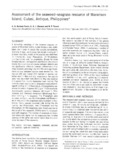Assessment of the seaweed-seagrass resource of Mararison Island, Culasi, Antique, Philippines

Quan điểm/
Request this document
Ngày
1998Page views
401metadata
Hiển thị bản ghi đầy đủ mặt hàngCited times in Scopus
Share
trừu tượng
A bimonthly sampling of the seaweed-seagrass resource of Mararison Island, Culasi Antique, was undertaken over 1 year to assess the species composition, similarity of taxa, and biomass (dry weight [d.w.] g m−2) at seven localities. A total of 45 species was identified: 17 Chlorophyta, seven Phaeophyta, 15 Rhodophyta, one Cyanophyta and five seagrasses. Except for some Rhodophyta and Syringodium isoetifolium (Ascherson) Dandy, the occurrence of species between stations was not significantly different; however, differences in biomass between sampling time (month) were significant. Identical taxa between stations were determined. The highest (40) and lowest (22) number of species collected were in May and July, respectively. The species were most abundant from March to May (dry months) and sparse from July to September (wet months). The most abundant species were: Sargassum polycystum C. Agardh (399 g m−2) (Phaeophyta), Dictyosphaeria cav-ernosa (Forsskat) Borgesen (43.1 g m−2) (Chlorophyta), Acanthopeitis japonica Okamura (97.2 gm−2) (Rhodophyta) and Thalassia hemprichii (Ehrenberg) Ascherson (1370 g m−2; seagrass). The Phaeophyta were abundant in March, and the Chlorophyta and Rhodophyta in May, while the seagrasses were abundant in September. Some species occurred only during the dry months: two Phaeophyta, nine Chlorophyta and five Rhodophyta. All the seagrasses were found year-round. Almost all of the seaweeds (39/45) were found associated with seagrass. The number of seaweeds in Mararison Island was higher than for seagrasses but the total biomass of the latter was much higher than the combined biomass of the seaweeds.
Suggested Citation
Hurtado-Ponce, A. Q., Chavoso, E. A. J., & Parami, N. P. (1998). Assessment of the seaweed-seagrass resource of Mararison Island, Culasi, Antique, Philippines. Phycological Research , 46(3), 175-181. https://doi.org/10.1111/j.1440-1835.1998.tb00111.x
Chủ thể
Taxonomic term
Bộ sưu tập
- AQD Journal Articles [1230]


